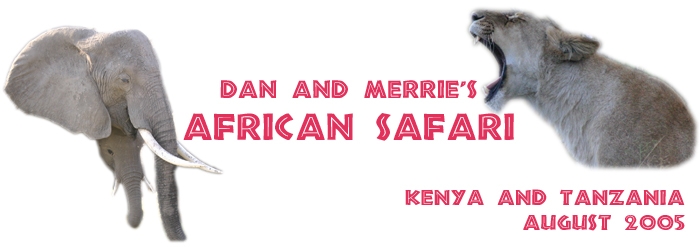|
|
In Tanzania, we sized up to a Land Rover to handle the tough descent into Ngorongoro Crater. Here we are at the entrance to Tarangire.
|
|
|
Merrie poses in front of a baobob tree, quite common in Tarangire. This one was just outside the park; the trees more toward the center of the park had no bark below about 15 feet, since the elephants like to eat the bark, and Tarangire has more elephants than any other park in East Africa.
|
|
|
A group of zebras wander through the tall grasses. The smallest one is quite young, although it's already developed its black adult stripes (for the first few months of their lives, zebra have brown stripes).
|
|
|
Can you find the hyrax in this picture?
|
|
|
A seemingly-infinite line of baboons stretches out from the river and onto the road. They were going to bed; it was around 7pm, and they have a spot at which they like to spend the night.
|
|
|
Tarangire was loaded with elephants, and they often hung out by the river (which was hardly a river during the dry season).
|
|
|
A hyrax had taken up residence in the (outdoor) basement of our hotel. The hyrax is the closet living relative of the elephant, despite its small size and squirrel-like appearance.
|
|
|
Our guide, Yusuph, picked up some baobob fruits for us to try. They were pretty sour, but not altogether unappetizing.
|
|
|
Weaver nests dotted just about every tree in tarangire. Most of the weavers were actually away; they make their nests at multiple locations and migrate among them. Here we actually see a couple of buffalo weavers.
|
|
|
We were surprised to see marabou stork roosting in the trees of Tarangire.
|
|
|
Three bare-faced go-away birds.
|
|
|
A giraffe wanders among the trees.
|
|
|
Dik-dik - among the smallest antelopes, at just a foot or two tall - were surprisingly visible all over Tarangire, often in mating pairs.
|
|
|
Another hyrax hangs out in the trees. All the hyraxes we saw were rock hyraxes (as opposed to tree hyraxes), even this one.
|
|
|
This is a Von der Decken's hornbill, one of several species of hornbill we found at Tarangire. In fact a pair of these hung out outside the window at our breakfast this morning, trying to figure a way in.
|
|
|
A white-backed vulture looks imposing atop a tall tree.
|
|
|
A giraffe eyes us with some uncertainty from his spot amongst the acacia trees right now. Hanging out in an acacia forest like this is - for a giraffe - roughly equivalent to me (Dan) standing in a room full of pizza and Jamba Juice.
|
|
|
A mating pair of lions, just five or ten feet from us. Lions are only seen in male-female pairs when they're actively mating, which they do for about three days without hunting at all. After mating, the male goes off on his own for a few months, but returns to help care for the cubs and to protect them from other males.
|
|
|
Another one of the six thousand elephants that usually call Tarangire home.
|
|
|
A lesser kudu bounds across the road. We never managed to find a greater kudu, but even the smaller spiraled horns on this guy are quite impressive.
|
|
|
The lilac-breasted roller is one of the prettiest birds we saw. It's called a "roller" because the male literally spins around its body as it flies to impress females.
|
|
|
A pair of southern ground hornbills, much larger than the Von der Decken's hornbills we saw earlier.
|
|
|
A young male impala (his horns are not full-sized yet) munches on leaves.
|
|
|
A bachelor herd of impala hides among the trees. Impala are always found in mating herds (one male and numerous females) and bachelor herds (a group of males waiting for their chance to challenge for a mating herd).
|
|
|
A baby elephant nursing...
|
|
|
...while a brother or sister eats nearby.
|
|
|
We got out of the truck for a few minutes to get a better look at a python that was barely visible way up in one of the trees (this is Dan, not a python)...
|
|
|
...and while we were walking around, just a hundred yards away (over a ridge and out of view), two lions were finishing off a wildebeest. We arrived just after the kill (our second near miss in the quest to see the hunt). Here the lions - two females - rest after their kill.
|
|
|
Lions are usually pretty tired after a kill, so they typically rest for a couple hours before dragging the kill to a cooler location (if necessary) and beginning the hard work of tearing through a wildebeest's hide.
|
|
|
Finally one of the lions starts to drag the wildebeest toward the bushes.
|
|
|
A male ostrich blocks our way. The ostrich, like many of
the large animals, were generally uninterested in us and didn't do much to
avoid people or cars.
|
|
|
Back out our hotel, a colorful red-headed agama and a rock hyrax catch some sun on the root.
|
|
|
The female red-headed agama - just a few feet away - doesn't actually have a red head.
|
|
|
Another elephant blocks the road on our way out of Tarangire.
|


